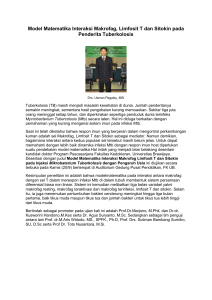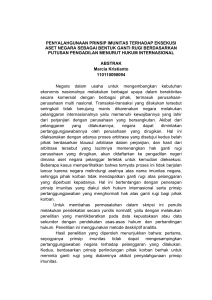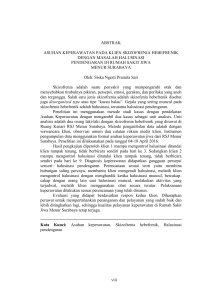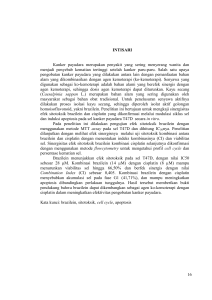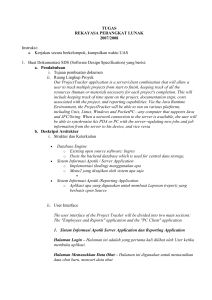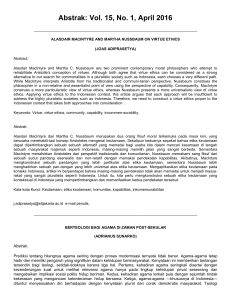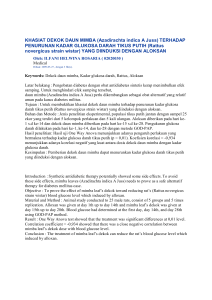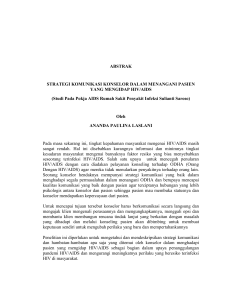Gaya - WordPress.com
advertisement
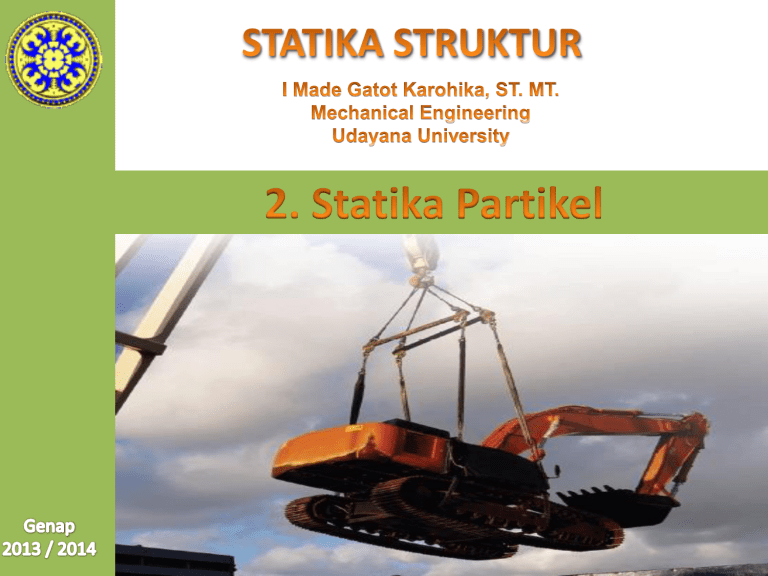
Contents
Introduction
Resultant of Two Forces
Vectors
Addition of Vectors
Resultant of Several Concurrent Forces
Sample Problem 2.1
Sample Problem 2.2
Rectangular Components of a Force: Unit
Vectors
Addition of Forces by Summing
Components
Sample Problem 2.3
Equilibrium of a Particle
Free-Body Diagrams
Sample Problem 2.4
Sample Problem 2.6
Rectangular Components in Space
Sample Problem 2.7
2-2
Pendahuluan
• Dalam bab ini, kita akan mempelajari pengaruh gaya-gaya yang bekerja pada
partikel:
- Mempelajari cara mengganti dua atau lebih gaya [multiple forces]
yang bekerja pada suatu partikel menjadi sebuah gaya tunggal
[resultant force] yang pengaruhnya sama seperti gaya-gaya semula,
- Menurunkan hubungan-hubungan yang ada antara berbagai
gaya yang bekerja pada suatu partikel dalam kondisi seimbang
[equilibrium] dan memakai hubungan ini untuk menentukan
beberapa gaya-gaya yang bekerja pada partikel tersebut.
• Pemakaian kata “partikel” tidak berarti bahwa kita membatasi pelajaran kita
pada benda yang kecil [miniscule bodies]. Yang dimaksud disini adalah ukuran
dan bentuk benda yang dianalisa tidak banyak [ tidak significant] mempengaruhi
penyelesaian masalah, sehingga semua gaya yang bekerja pada suatu benda
akan diasumsikan bekerja di titik yang sama.
2-3
• Force [Gaya]: aksi sebuah benda pada benda
lain; ditentukan oleh its point of application
[titik kerjanya], magnitude [besarnya], line of
action [garis aksi], and sense [arah].
• Dari Percobaan menunjukkan bahwa pengaruh
kombinasi dari dua gaya dapat digantikan dengan
sebuah gaya resultan.
• Gaya resultant adalah equivalent dengan diagonal
of a parallelogram [jajaran genjang] dengan dua
gaya pada kedua sisinya.
• Force [ gaya ] adalah besaran vector .
2-4
Vectors
• Vector: parameters yang mempunyai besar dan arah, yang
penjumlahannya mengikuti hukum jajaran genjang
[parallelogram law]. Examples: displacements [perpindahan],
velocities [kecepatan], accelerations [percepatan], momen.
• Scalar: parameters yang mempunyai besar tetapi tidak
mempunyai arah. Ex: mass, volume, temperature
• Klasifikasi Vector:
- Tertentu atau terikat; vectors mempunyai titik tangkap yang
pasti yaitu partikel itu sendiri yang tidak dapat dipindahkan
tanpa merubah kondisi soal yang ditinjau/analisa [ex: gaya
pada partikel].
- Bebas; vectors yang dapat diubah dengan bebas dalam
ruang tanpa mempengaruhi analisa [ex: kopel gaya].
- Geser; vectors yang dapat dipindahkan, atau menggeser
sepanjang garis aksi [ex: gaya pada benda tegar].
• Vector Equal atau sama : vectors mempunyai besar dan
arahnya sama.
• Negative vector of a given vector has the same magnitude and
the opposite direction.
2-5
• Hukum jajaran genjang untuk
penjumlahan vector.
• Hukum segitiga untuk penjumlahan vektor
• Law of cosines,
C
B
C
B
R 2 P 2 Q 2 2 PQ cos B{analisa}
R P Q [penulisan secara vektor]
• Law of sines,
sin A sin B sin C
Q
R
P
• Penjumlahan Vector adalah bersifat commutative,
PQ Q P
• Vector subtraction
P Q P (Q)
2-6
Penjumlahan Vector______________cont…
• Penjumlahan dari tiga atau lebih vektor dengan
penggunaan berulang dari hukum segitiga
• Aturan poligon untuk penjumlahan tiga atau lebih
vector.
• Penjumlahan Vector adalah associative,
P Q S P Q S P Q S
• Perkalian vektor dengan skalar
2-7
Resultant of Several Concurrent Forces
• Concurrent forces: sekumpulan gaya yang
melalui titik yang sama.
Sekumpulan gaya concurrent yang diterapkan
pada sebuah partikel dapat digantikan dengan
sebuah resultant force yang merupakan
penjumlahan vektor dari gaya-gaya yang bekerja.
• Vector force components: two or more force
vectors which, together, have the same effect as
a single force vector.
2-8
Sample Problem 2.1
SOLUTION:
• Graphical solution - construct a
parallelogram with sides in the same
direction as P and Q and lengths in
proportion. Graphically evaluate the
resultant which is equivalent in direction and
proportional in magnitude to the the
diagonal.
Dua buah gaya P dan Q beraksi
pada suatu paku A.
Tentukan resultannya
• Trigonometric solution - use the triangle rule
for vector addition in conjunction with the
law of cosines and law of sines to find the
resultant.
2-9
Sample Problem 2.1
• Graphical solution – Jajaran genjang dengan sisi
sama dengan P dan Q digambar mengikuti skala.
Besar dan arah gaya reultan diukur dan diperoleh,
R 98 N 35
• Graphical solution – hukum segitiga dapat pula
digunakan. Gaya P dan Q digambar megikuti skala
dengan cara menghubungkan ujung dan ekor gaya.
Kemudian besar dan arah gaya diukur,
R 98 N 35
2 - 10
Sample Problem 2.1
• Trigonometric solution – hukum segitiga digunakan lagi
disini, dua sisi dengan sudutnya diketahui. Dengan
memakai rumus kosinus dapat dicari,
R 2 P 2 Q 2 2 PQ cos B
40N 2 60N 2 240N 60N cos155
R 97.73N
Dari rumus sinus ditulis,
sin A sin B
Q
R
sin A sin B
Q
R
sin 155
A 15.04
20 A
35.04
60N
97.73N
2 - 11
Sample Problem 2.2
SOLUTION:
• Find a graphical solution by applying the
Parallelogram Rule for vector addition. The
parallelogram has sides in the directions of the
two ropes and a diagonal in the direction of the
barge axis and length proportional to 5000 lbf.
Sebuah tongkang ditarik oleh dua
• Find a trigonometric solution by applying the
kapal penyeret. Jika resultan gaya
Triangle Rule for vector addition. With the
yang dilakukan oleh kapal penyeret
magnitude and direction of the resultant known
sebesar 5000 lbf diarahkan sepanjang
and the directions of the other two sides
sumbu tongkang, tentukanlah:
parallel to the ropes given, apply the Law of
Sines to find the rope tensions.
a) gaya pada masing-masing tali,
dengan mengetahui = 45o,
• The angle for minimum tension in rope 2 is
b) Harga dari agar gaya pada tali 2
minimum.
determined by applying the Triangle Rule and
observing the effect of variations in .
2 - 12
Sample Problem 2.2
a) Gaya untuk = 45o
• Graphical solution – dengan menggunakan
hukum jajarangenjang dapat diperoleh
diagonal(resultan) sebesar 5000 lbf dengan
arah kekanan. Sisi-sisinya digambarkan sejajar
dengan kedua tali. Bila gambar dilakukan
mengikuti skala, kita peroleh :
T1 3700 lbf
T2 2600 lbf
• Trigonometric solution - hukum segitiga dan
hukum sinus ,
T1
T2
5000lbf
sin 45 sin 30 sin 105
T1 3660 lbf
T2 2590 lbf
2 - 13
Sample Problem 2.2
b) Mencari harga untuk gaya T2 minimum
• Untuk menentukan harga agar tali 2 (T2)
minimum, hukum segitiga kita gunakan. Dalam
gambar yang ditunjukkan garis 1 – 1’ adalah arah
T1 yang diketahui. Beberapa kemungkinan arah
T2 ditunjukkan oleh garis 2 – 2’.
• Dapat kita lihat bahwa harga T2 minimum bila T1
dan T2 saling tegak lurus. Harga mimimum T2 :
T2 5000 lbf sin 30
T2 2500 lbf
T1 5000 lbf cos 30
T1 4330 lbf
90 30
60
2 - 14
Quis (10 menit)
Dua buah gaya P dan Q beraksi
pada suatu paku hook A.
Tentukan besar dan arah
resultannya
(a) secara grafis dengan hukum
jajaran genjang dan segitiga
(b) secara trigonometik
Rectangular Components of a Force: Unit Vectors
• May resolve a force vector into perpendicular components
so
that the resulting parallelogram is a rectangle. Fx and Fy are
referred to as rectangular vector components and
F Fx Fy
• Define perpendicular unit vectors i and j which are
parallel to the x and y axes.
• Vector components may be expressed as products of the
unit vectors with the scalar magnitudes of the vector
components.
F Fx i Fy j
Fx and Fy are referred to as the scalar components of F
2 - 16
Addition of Forces by Summing Components
• Wish to find the resultant of 3 or more concurrent
forces,
R PQS
• Resolve each force into rectangular components
Rx i R y j Px i Py j Qx i Q y j S x i S y j
Px Qx S x i Py Q y S y j
• The scalar components of the resultant are equal to
the sum of the corresponding scalar components of
the given forces.
Rx Px Qx S x
Fx
R y Py Q y S y
Fy
• To find the resultant magnitude and direction,
R
Rx2
R y2
tan
1
Ry
Rx
2 - 17
Sample Problem 2.3
SOLUTION:
• Uraikan masing-masing gaya menjadi
komponen tegak lurusnya.
• Tentukan komponen-komponen dari
resultan dengan menambahkan
berdasarkan komponen gayanya.
• Hitung besar dan arah resultan.
Empat gaya bekerja pada titik A, seperti
pada gambar. Tentukan resultan gayagaya yang bekerja pada baut.
2 - 18
Sample Problem 2.3
SOLUTION:
• Uraikan masing-masing gaya menjadi komponen
tegak lurus.
force mag
F1 150
F2
80
F3 110
F4 100
x comp
y comp
129.9
75.0
27.4
75.2
0
110.0
96.6
25.9
Rx 199.1 R y 14.3
• Tentukan komponen-komponen dari resultan
dengan menambahkan berdasarkan komponen
gayanya.
• Hitung besar dan arah resultan.
R 199.12 14.32
14.3 N
tan
199.1 N
R 199.6 N
4.1
2 - 19
Equilibrium of a Particle
• When the resultant of all forces acting on a particle is zero, the particle is in
equilibrium.
• Newton’s First Law: If the resultant force on a particle is zero, the particle will remain at
rest or will continue at constant speed in a straight line.
• Particle acted upon by two
forces:
- equal magnitude
- same line of action
- opposite sense
• Particle acted upon by three or more forces:
- graphical solution yields a closed polygon
- algebraic solution
R F 0
Fx 0
Fy 0
2 - 20
Free-Body Diagrams
Space Diagram: A sketch showing the
physical conditions of the problem.
Free-Body Diagram: A sketch showing only
the forces on the selected particle.
2 - 21
Sample Problem 2.4
SOLUTION:
• Construct a free-body diagram for the
particle at the junction of the rope and
cable.
• Apply the conditions for equilibrium by
creating a closed polygon from the forces
applied to the particle.
• Apply trigonometric relations to determine
the unknown force magnitudes.
Dalam suatu operasi bongkar muat kapal,
sebuah mobil seberat 3500-lb diangkat oleh
seutas kabel. Seutas tali diikatkan pada kabel
tersebut di titik A dan ditarik agar mobil
sampai ketempat yang dikehendaki. Sudut
antara kabel dan arah vertikal adalah 2o,
sedang sudut antara tali dan arah horisontal
30o. Berapa gaya tali
2 - 22
Sample Problem 2.4
SOLUTION:
• Construct a free-body diagram for the
particle at A.
• Apply the conditions for equilibrium.
• Solve for the unknown force magnitudes.
T AC
T AB
3500 lb
sin 120 sin 2 sin 58
T AB 3570 lb
TAC 144 lb
2 - 23
Sample Problem 2.6
SOLUTION:
• Choosing the hull as the free body, draw a
free-body diagram.
• Express the condition for equilibrium for
the hull by writing that the sum of all
forces must be zero.
It is desired to determine the drag force at
a given speed on a prototype sailboat hull.
A model is placed in a test channel and
three cables are used to align its bow on
the channel centerline. For a given speed,
the tension is 40 lb in cable AB and 60 lb in
cable AE.
• Resolve the vector equilibrium equation
into two component equations. Solve for
the two unknown cable tensions.
Determine the drag force exerted on the
hull and the tension in cable AC.
2 - 24
Sample Problem 2.6
SOLUTION:
• Choosing the hull as the free body, draw a
free-body diagram.
7 ft
1.75
4 ft
60.25
tan
1.5 ft
0.375
4 ft
20.56
tan
• Express the condition for equilibrium for
the hull by writing that the sum of all
forces must be zero.
R T AB T AC T AE FD 0
2 - 25
Sample Problem 2.6
• Resolve the vector equilibrium equation into two
component equations. Solve for the two unknown
cable tensions.
T AB 40 lb sin 60.26 i 40 lb cos 60.26 j
34.73 lb i 19.84 lb j
T AC T AC sin 20.56 i T AC cos 20.56 j
0.3512T AC i 0.9363T AC j
T 60 lb i
FD FD i
R0
34.73 0.3512T AC FD i
19.84 0.9363T AC 60 j
2 - 26
Sample Problem 2.6
R0
34.73 0.3512T AC FD i
19.84 0.9363T AC 60 j
This equation is satisfied only if each component of
the resultant is equal to zero
Fx 0 0 34.73 0.3512TAC FD
Fy 0 0 19.84 0.9363TAC 60
TAC 42.9 lb
FD 19.66 lb
2 - 27
Rectangular Components in Space
• The vector F is
• Resolve F into
contained in the plane
horizontal and vertical
OBAC.
components.
Fy F cos y
Fh F sin y
• Resolve Fh into
rectangular components
Fx Fh cos
F sin y cos
Fy Fh sin
F sin y sin
2 - 28
Rectangular Components in Space
• With the angles between F and the axes,
Fx F cos x Fy F cos y Fz F cos z
F Fx i Fy j Fz k
F cos x i cos y j cos z k
F
cos x i cos y j cos z k
• is a unit vector along the line of action of F
and cos x , cos y , and cos z are the direction
cosines for F
2 - 29
Rectangular Components in Space
Direction of the force is defined by the
location of two points,
M x1 , y1 , z1 and N x2 , y 2 , z 2
d vector joining M and N
d xi d y j d z k
d x x2 x1 d y y 2 y1 d z z 2 z1
F F
1
d x i d y j d z k
d
Fd y
Fd x
Fd z
Fx
Fy
Fz
d
d
d
2 - 30
Sample Problem 2.7
SOLUTION:
• Based on the relative locations of the points
A and B, determine the unit vector pointing
from A towards B.
• Apply the unit vector to determine the
components of the force acting on A.
The tension in the guy wire is 2500 N.
Determine:
• Noting that the components of the unit
vector are the direction cosines for the
vector, calculate the corresponding angles.
a) components Fx, Fy, Fz of the force
acting on the bolt at A,
b) the angles x, y, z defining the
direction of the force
2 - 31
Sample Problem 2.7
SOLUTION:
• Determine the unit vector pointing from A towards B.
AB 40 m i 80 m j 30 m k
AB
40 m 2 80 m 2 30 m 2
94.3 m
40 80 30
i
j
k
94
.
3
94
.
3
94
.
3
0.424 i 0.848 j 0.318k
• Determine the components of the force.
F F
2500 N 0.424 i 0.848 j 0.318k
1060 N i 2120 N j 795 N k
2 - 32
Sample Problem 2.7
• Noting that the components of the unit vector are the
direction cosines for the vector, calculate the
corresponding angles.
cos x i cos y j cos z k
0.424 i 0.848 j 0.318k
x 115.1
y 32.0
z 71.5
2 - 33
thanks

